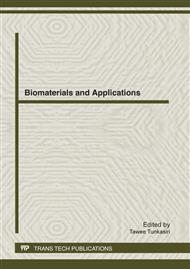p.513
p.517
p.521
p.525
p.529
p.533
p.537
p.541
p.545
Influence of Diluents on Physical Properties of Soybean Extracted Powder Prepared by Spray Drying Method
Abstract:
soflavones, a special phenolic group found in soybean, have been found to act as antioxidant and are widely used in pharmaceutics and nutraceuticals. Due to the storage and handling problem, the extract has been prepared in dry form by spray drying technique. The condition of extract solution prior to spray drying has been reported to affect the property of dried powder. The aim of this work was to evaluate the effect of diluents on the physical properties of soybean extracted powder. The experiment was carried out by a Büchi B-290 Mini Spray Dryer. Four types of diluents were applied, they weremannitol, maltrodextrin, and 2 types of modified starch The comparison was then made among those with diluents and without diluent as a carrier. The physicochemical property was then characterized for flowability, moisture content, morphology, particle size and X-ray diffraction. From the results, the addition of all diluents could improve the physicochemical properties of soybean extracted powder indicating the improvement in morphology and hence the better flow property .The types of diluent also had the effect on the extracted powder. Maltodextrin and modified starch exhibited the best carrier in term of improvement of flow property. Therefore, the spray drying technique was successfully used to prepare microparticles of soybean extracted powder and by taking into consideration of the selection of suitable diluents, the good quality of soybean extracted powder could be achieved.
Info:
Periodical:
Pages:
529-532
Citation:
Online since:
April 2012
Authors:
Keywords:
Price:
Сopyright:
© 2012 Trans Tech Publications Ltd. All Rights Reserved
Share:
Citation:


